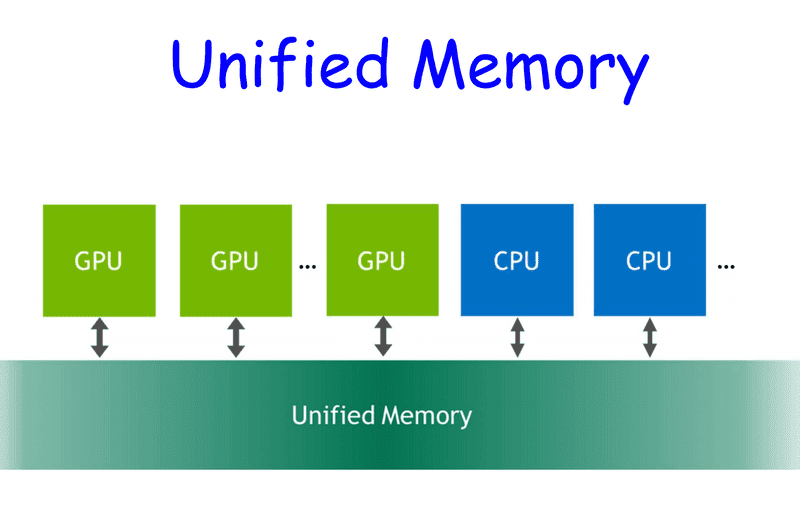CUDA Unified Virtual Address Space & Unified Memory
Unified Virtual Address Space (UVA)
From CUDA 4.0 and on, UVA has been an important feature. It
- puts all CUDA execution, host and GPUs, in the same address space
- Requires Fermi-class GPU and above
- Requires 64-bit application
- Call
cudaGetDeviceProperties()for all participating devices and checkunifiedAddressingflag
easier memory access with UVA
Zero-copy
- UVA provides a single virtual memory address space for all memory in the system, and enables pointers to be accessed from GPU code no matter where in the system they reside.
- Pointers returned by cudaHostAlloc() can be used directly from within kernels running on UVA enabled devices – Data cache in L2 of target device.
easier memory copy with UVA
between host and multiple devices
cudaMemcpy(gpu0_buf, host_buf, buf_size, cudaMemcpyDefault)
cudaMemcpy(gpu1_buf, host_buf, buf_size, cudaMemcpyDefault)
cudaMemcpy(host_buf, gpu0_buf, buf_size, cudaMemcpyDefault)
cudaMemcpy(host_buf, gpu1_buf, buf_size, cudaMemcpyDefault)between two devices:
cudaMemcpy(gpu0_buf, gpu1_buf, buf_size, cudaMemcpyDefault)cudaMemcpy() knows that our buffers are on different devices.
Unified Memory
Available for CUDA 6.0 and up.
Creates a pool of managed memory that is shared between the CPU and GPU.
- Managed memory is accessible to CPU and GPU with single pointers.
-
Under the hood: data (granularity = pages) automatically migrates from CPU to GPU and among GPUs.
- Pascal GPU architecture is the first with hardware support for virtual memory page faulting and migration.
usage
cudaError_t cudaMallocManaged(void** ptr, size_t size)ptr can be used by any GPU and CPU in the system.
Pascal GPU:
- Pages may not be created until they are accessed by the GPU or the CPU.
- Pages automatically migrate to the device (or host) that access them.
Pre-PASCAL (i.e. Kepler and Maxwell)
- With single GPU, data will be allocated on the GPU device that is active when the call is made.
- On multi-GPU systems, if some of the GPUs have peer-to-peer access disabled, the memory will be allocated so it is initially resident on the CPU.
example
int main() {
int *ret;
cudaMallocManaged(&ret, 1000 * sizeof(int));
AplusB<<< 1, 1000 >>>(ret, 10, 100);
cudaDeviceSynchronize();
for(int i=0; i<1000; i++)
printf("%d: A+B = %d\n", i, ret[i]);
cudaFree(ret);
return 0;
}difference between UVA and unified memory
- Unified memory depends on UVA.
- UVA does NOT move data automatically between CPU and GPU.
- Unified memory gives higher performance than UVA.
pros and cons of unified memory
advantages
- Ease of programming
- Data is migrated on demand – offer the performance of local data on the GPU – while providing the ease of use of globally shared data
- Very efficient with complex data structures (e.g. linked lists, structures with pointers, … ).
disadvantage
Carefully tuned CUDA program that uses streams to efficiently overlap execution with data transfers may perform better than a CUDA program that only uses Unified Memory.

